Flooding Facebook – the use of social media during the Queensland and Victorian floods
Deanne Bird, Megan Ling, Katharine Haynes
Peer-reviewed Article
Abstract
Article
Introduction
Facebook is a web-based social networking service, allowing registered users the ability to connect and share with friends, family and co-workers, join common interest groups and ‘like’ (essentially subscribe to) businesses. Established in February 2004, Facebook currently has more than 800 million users globally (users who have returned to the site in the last 30 days), is available in 70 languages and is growing at around 150% per year (Facebook, 2012a, b). While Facebook is the largest and most widely used social networking service, other services such as Twitter, MySpace, Google+ and Hi5 are also popular.
In addition to the traditional method of accessing social media via desktop computers, a survey has shown that Australians are just as likely to access social networking sites via a smartphone (Moses, 2011). Offering advanced computer ability and connectivity, smartphones are high-end mobile phones with Australia leading the way in penetration rates, behind Singapore (OurMobilePlanet, 2011). ‘The Nielsen Company’ survey showed that nearly a third of users who access the internet through their smartphone, log on to social networking sites daily (Telstra, 2010).
This increasing trend of accessing social media via smartphones makes social networks particularly useful during a disaster when power disruptions may eliminate television and radio. While many phone networks are themselves unable to cope with the hundreds of thousands of people trying to call or text immediately after a disaster, Facebook and Twitter, which have the capacity to deal with such large volumes, can remain online and communicate amongst other things, requests for assistance. Within minutes of the March 2011 To-hoku earthquake, the word ‘Japan’ was recorded in dozens of posts on Facebook and, within one hour, almost 1,200 tweets per minute (Twitter messages) were coming from Tokyo (Spong, 2011). It was a similar story following the July 2011 bombings in Mumbai (A.A.K., 2011) and following the 2010 Haiti earthquake when social media was used to coordinate emergency response efforts (Yates and Paquette, 2011).
In America, the Director of Social Strategies for the Red Cross stated that “During the record-breaking 2011 spring storm season, people across America alerted the Red Cross to their needs via Facebook. We also used Twitter to connect to thousands of people seeking comfort and safety information to help get them through the darkest hours of storms” (American Red Cross, 2011).
In Australia, we saw the emergence of social media as an effective method of disseminating information during the 2011 floods in Queensland and Victoria. Significantly, the Queensland Police Service Facebook page became a key source of information and its popularity rapidly grew as the wet season continued to impact the state (Fig 1). Heavy rain and flooding associated with Tropical Cyclone Tasha resulted in the numbers of ‘likes’ doubling. During the 24-hour period following the flash flooding in Toowoomba and the Lockyer Valley on 10 January 2011, the number of ‘likes’ increased from 17,000 to 100,000 with an average of 450 post views per second (QPS, 2011). The media also relied on information posted through the Queensland Police Service social media sites, with radio and television anchors reading reports within moments of them being published. This resulted in the dissemination of information at an unprecedented rate to large numbers of people (QPS, 2011).
Figure 1. Growth of the Queensland Police Service Facebook page ‘likes’ from May 2010 to February 2011 and the events that potentially impacted its popularity (Charlton, 2011; p. iv). Note that Cyclone Yasi weakened prior to making landfall.

In addition, Facebook community group pages appeared almost simultaneously with the floodwaters – for example, Rockhampton and CQ Floods 2010 was created on 29 December 2010 and by 3 February 2011 had more than 8,600 ‘likes’. The group Toowoomba & Darling Downs Flood Photos & Info was created at 16.55 on 10 January 2011, just hours after the flooding began, and within a month had 37,700 ‘likes’. This means that 37,700 people looked at the site and “liked” what they saw or used the ‘like’ function to demonstrate support for the victims. However, it is likely that many more people used the site for obtaining or distributing information.
In an interview with Rockhampton’s local paper, The Morning Bulletin, Garrett Wells and Andrew Hunter, creators of CQ Flood Update and Rockhampton and CQ Floods 2010, two of the most ‘liked’ and most viewed Facebook pages, stated that they simply started the pages to assist their families and to allow people to share photos (Mcbryde, 2011). Their sources of information included the Queensland Police Service, State Emergency Service (SES), local councils and the Royal Society for the Prevention of Cruelty to Animals (RSPCA), but the most important resource was local people.
In the days following and during the Queensland and Victorian floods, Risk Frontiers conducted a survey of people who were members of a number of community Facebook pages. The survey sought to discover how people found out about the existence of the pages, what they were hoping to learn, and what they did with the information. The next sections describe the survey methods and key results.
Online survey method
An online questionnaire was developed and advertised through a posting on various Facebook community group pages, including CQ Flood Update-version 2 and Victorian Floods. The posting included a short description about the aim of the survey and a link to the online questionnaire, which was hosted by SurveyMonkey®. The invitation to participate was open from January to March 2011 to anyone who accessed these Facebook groups.
The questionnaire contained 14 closed and 4 open questions covering the following topics:
- Respondent demographics
- How and why people used Facebook during the floods in Queensland/Victoria
- Perception of the quality of information on the floods
- Use of other social media for flood information including government and media Facebook groups, websites and Twitter
- Perception of information on Facebook websites in terms of accuracy, timeliness, usefulness and trustworthiness
Open text boxes accompanied several questions to give respondents the opportunity to provide more details, if desired.
An electronic copy of the questionnaire is available from the lead author on request.
Respondent demographics
In total, 432 people responded to the survey. Respondents were widespread with 194 unique postcodes (from 361) around Australia (Fig 2) with the highest representation from Toowoomba, Queensland (16%). In addition, a number of respondents were from New Zealand, Germany and the USA.
Figure 2. Centroids of Australian respondent’s postcodes. Map produced by Keping Chen (Risk Frontiers).
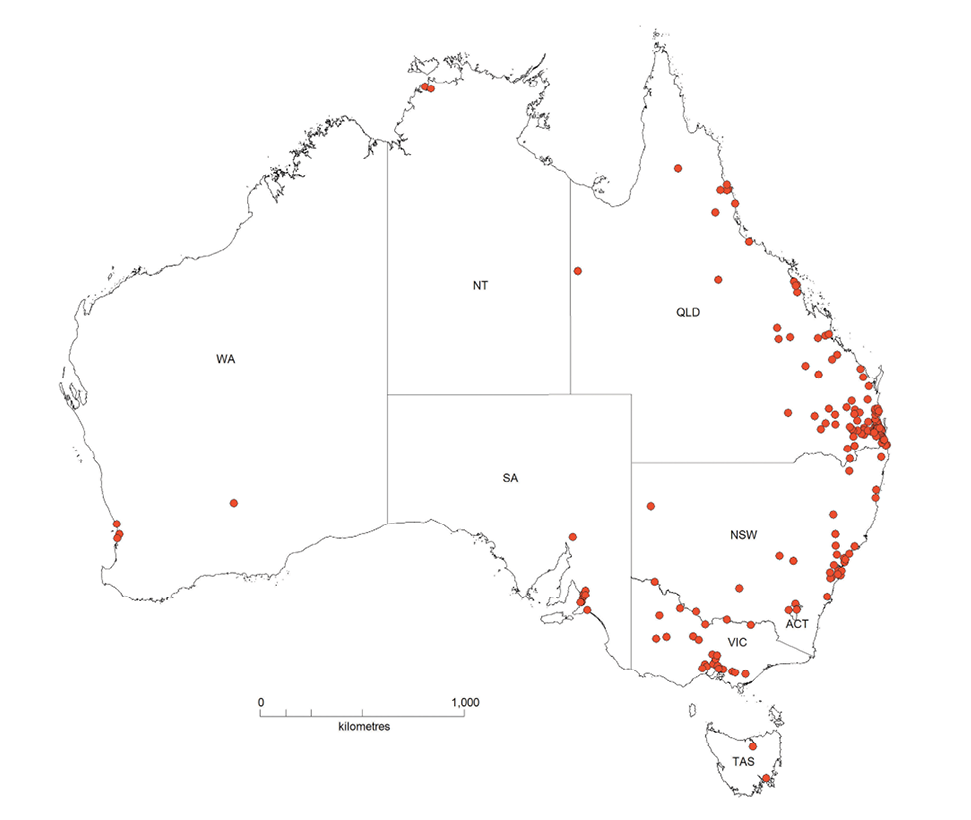
92% of the respondents were female and 33% were between the ages of 25-34 and 30% were between 35-44 (Fig 3). A number of factors might potentially skew the distribution: the demographics of these Facebook pages, which generally show about three-quarters of users are female and under 44 years of age (QPS, 2011, Dufty, 2011), and the demographics of the subset of those users who are willing to participate in an online survey.
Figure 3. Respondents' age
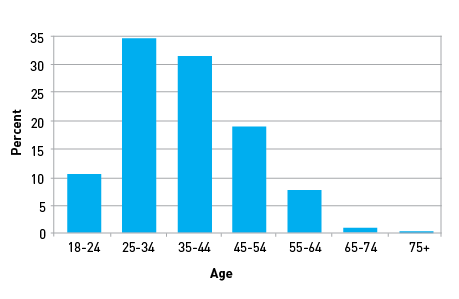
How and why people used Facebook during the floods in Queensland and Victoria
Most respondents accessed the community Facebook groups following an invitation from a Facebook friend or through a Facebook search (Fig 4).
Figure 4. How respondents’ first heard about the Facebook groups on the floods in Queensland/Victoria.
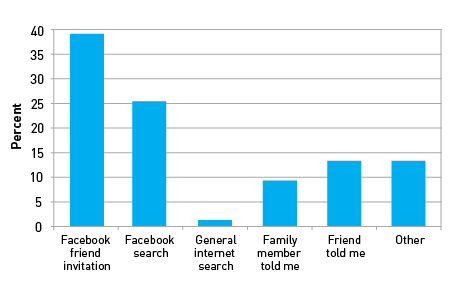
Many users relied on these pages for flood-related information during the worst phases of the disaster and nearly two-thirds of respondents used the Facebook groups to gain information about their own community (Fig 5). Other people were using the pages to gain information about the communities of their family and friends, and most importantly, nearly all respondents (97%) communicated this knowledge directly back to family and friends.
Figure 5. Respondents’ reasons for signing up to, or looking at, the Facebook groups on the floods in Queensland/Victoria.
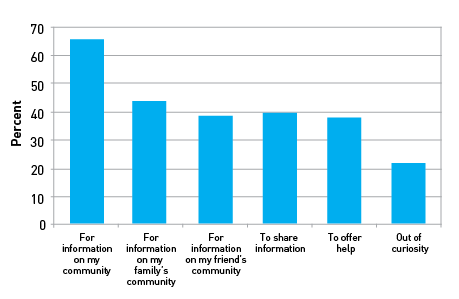
Perception of the quality of information on the floods in Queensland/Victoria on Facebook
Almost all respondents (99%) found the information useful and less than half (39%) reported conflicting and inaccurate information. Overall, the majority of people trusted the information posted on Facebook (Fig 6).
Figure 6. Respondents’ level of trust in information on the floods in Queensland/Victoria on Facebook.
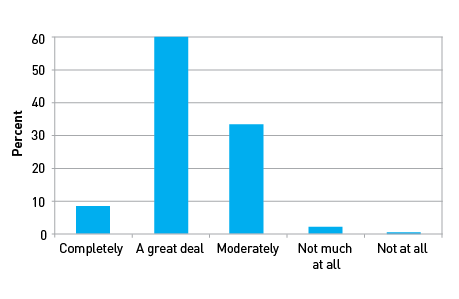
Greatest concerns about conflicting and inaccurate information related to:
- Reports of roads being closed or open
- Reports of areas in need of volunteers
- Incorrect information about businesses (over/under pricing)
- Reports of fuel shortages
- Death tolls and missing persons
- Comments which were considered offensive, inappropriate or unnecessary
While rumours were common at the height of the disaster, respondents reported that the moderators of the Facebook pages were prompt at confirming information and providing official sources when available. When not available, local knowledge and discussions often provided confirmation on what was accurate. Also, Queensland Police Service used their Facebook page and Twitter to ‘mythbust’ rumours generated on community groups and through the media (QPS, 2011). Inaccurate information posted by a user was usually swiftly corrected by other users, making these pages self regulating.
“There were a few times that information was found to be incorrect but was later corrected - helped to be following the QPS [Queensland Police Service] page as well as other pages as the QPS had "mythbuster" comments to clarify incorrect messages in circulation.”
“The Queensland Police Facebook page is constantly squashing rumours. E.g. Wivenhoe Dam wall is not failing.”
“A few rumours were started online - I waited to see what more credible sources were posting - such as the Qld [Queensland] Police Service.”
“A lot of people post things they have heard, so you cannot be sure how accurate the information is. Lots of people posted links to sites, such as the Bureau of Meteorology which were very informative.”
“I've found the information posted by the QLD [Queensland] police service to be very accurate. The television media on the other hand, have been over dramatising most coverage. They seemed hell bent on getting a "record" flood, always slightly over estimating expected peaks, and showing footage of areas different to what is being spoken about. For example, horrific footage from Toowoomba was played constantly while talking about Ipswich.”
“Victoria DESPERATELY needs an emergency services site similar to those operated by Queensland Police (Floods) and Joint Emergency Services (cyclone Yasi) which dispels rumours and brings all emergency information together in one place in an accessible, human form.”
“There was talk about contamination in the water, but by friending [‘liking’] the QPS page, we were able to make sure we received correct information.”
Use of official sources and other social media for flood information
74 % of respondents stated that they had used government or media Facebook groups and websites with an overwhelming majority referencing the Queensland Police Service Facebook group. Other sources for information included: the State Emergency Services (SES), Australian Broadcasting Corporation (ABC) News, Bureau of Meteorology, VicRoads (Victoria Roads Authority), Victorian Police, Royal Automobile Club of Queensland (RACQ), various council websites and commercial news media sources. In comparison, Twitter usage was far less popular with only 6% of respondents indicating that they had used it to follow information on the floods. This result suggests that those people who use Facebook do not use Twitter but it does not tell us anything about the use of Twitter before, during or after a disaster.
Perception of the quality of information on Facebook and other websites
Respondents were asked to rank the information provided by community, government and media in terms of accuracy, timeliness, usefulness and trustworthiness. In terms of accuracy and trustworthiness, government Facebook groups and websites ranked higher than community groups (Fig 7). In comparison, community Facebook groups ranked higher than government groups and websites in terms of timeliness and usefulness.
Figure 7. Respondents’ perception of information from government, community and media sources in terms of accuracy, timeliness, usefulness and trustworthiness.
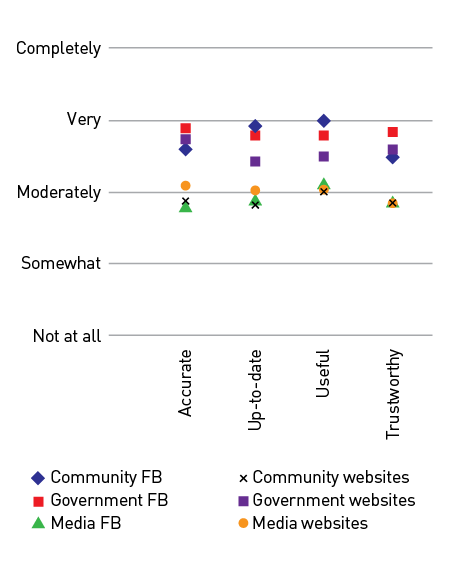
Open responses and comments verified the quantitative data and also provided further details and examples to broaden the analysis. Comments in relation to community sources noted the benefits of the local knowledge inherent in the community groups and that Facebook often remained the only form of communication when all others failed:
“Community groups are well placed as they are in the thick of it all and the information is timely and generally accurate.”
“As we were without mobile coverage and home phone communications due to the extreme events of last week - Facebook was our only means of communication and we found it more accurate that other sources - especially in regards to roads open/closed... people would comment/post if they got through roads that sites were saying were closed, etc...”
“By using Facebook, you connect directly with those in that AREA you're trying to get to. Media only cover the larger communities, I understand it's very hard to cover everyone everywhere.”
“Facebook and the internet have been our main source of local information as the media coverage has concentrated mainly on Grantham, Toowoomba and Brisbane (and now interstate) flooding.”
“Facebook was a valuable tool to me while my brother’s family were flooded in Qld and I in NSW [New South Wales]. Their land line was down, at one stage their Vodaphone mobile was down and my nephew ran out of credit on his phone. So there were times when Facebook was our contact with my nephew. He could share pictures and we could offer words of encouragement while they were flooded in.”
Comments in relation to government sources noted the accuracy but lack of timeliness:
“Government websites trail with information - not up to date like Facebook ones.”
“Government websites took too long to be updated.”
“I've basically just stayed with the Qld Police Facebook group. They've been very accurate in not only recording what's happening, but also mythbusting the rumours.”
“I found the Cardinia Shire website to have basically no information of worth - especially when I was trying to provide others with information. VicSES [Victoria State Emergency Service] did a shocking job on their FB [Facebook] page, only posting once every 10 hours. VicPol [Victoria Police] did a great job with every update and lots of them. VicRoads are a great resource, but the information is not quite as quick to be posted.”
Comments in relation to media sources noted the superiority of the ABC but the lack of local detail:
“ABC websites were the most accurate media site - largely because they avoided the language of hyperbole. Other websites focused on hyperbole e.g. ABC news coverage titled "Flood Special", commercial station labelled news coverage titled "Flood Disaster" to name one example. Community sites did not always provide accurate information, but members would correct the information and provide valid / official sources to confirm corrections.”
“I have found that Media websites (and television, commercial radio) are focusing more on the greater Brisbane area rather than the Lockyer Valley area. Facebook groups offer greater access to more information, allowing people to choose info on wider areas, OR more particular areas of interest, as well as offering basic information, or information on how to volunteer or what/ where/ how to donate. I also believe people being able to communicate what they have seen first-hand offers an outlet for them to try and deal with what they have come across, and to give a more genuine and personal idea of the issues to the wider public than Media can offer with interviews.”
Concluding discussion
The survey results presented here have shown the importance of Facebook during the Queensland and Victoria floods from a community perspective and provided a snap-shot of how people found out about the existence of the pages, what they hoped to learn and what they did with the information. While ABC Emergency is the official communication vehicle in a disaster, there is a time lag on the information delivered as it all must be verified prior to publication. In comparison, community Facebook group pages rely on real-time information from the general public and although timely, this information is not always accurate. However, administrators of community Facebook groups and other Facebook users quickly verify and correct any inaccurate reports. In addition, users often have to search for information and links on websites providing emergency information, whereas Facebook posts are delivered to a member’s newsfeed live, giving an advantage of convenience over other, more traditional, means of communication.
A number of the community and government groups discussed here have continued to provide valuable information well beyond the floods. For example, in response to the impending threat of Cyclone Yasi, the administrators from various Queensland flood community Facebook groups joined together to develop and manage a new community group page entitled Cyclone Yasi Update. At 11:00 am on 2 February 2011, the day before the cyclone was due to cross the coast near Innisfail, Far North Queensland, the group had about 14,000 ‘likes’. By 10:30 pm this had escalated to more than 52,000, and by 11:00 pm this was up to just over 63,000. Significantly, emergency management officials on ABC radio were acknowledging the importance of Facebook and Twitter during this cyclone. Today, many of these groups are still actively providing recovery support and local emergency information.
For many Australians, social media is a part of their everyday life and it can be used to effectively and efficiently disseminate emergency information on: the occurrence of hazards; location of evacuation centres and road closures; fundraising opportunities; volunteering; and, reassure people about the safety of family and friends. Social media will not replace traditional forms of hazard and risk communication, but rather, provides another useful tool that shares the responsibility of reducing risk, facilitates community involvement and empowers people to take action. Social media also allows agencies to tap into and review informal communication networks, something that was previously inaccessible, and ‘mythbust’ conflicting and inaccurate information.
Acknowledging the importance of social media, FEMA suggests that emergency management agencies should promote the following points in household preparedness strategies (Fugate, 2011; p. 4):
- “Store useful phone numbers in your phone, including local police, fire departments and your utility company;
- Create a group for your emergency contacts on your cell phone;
- Know what social media tools are available to you at the state and local level, so that you can quickly access them in the event of an emergency;
- Have an extra battery for your phone (or a solar charger) in your emergency kit;
- In the aftermath of a disaster, update your social media channels to let your friends and family know you are safe by simply saying “I'm OK.” This helps reduce the volume of phone calls in an area so that necessary communications can continue to be made.”
Acknowledgements
The authors would like to thank all those who took part in the Facebook survey and also the moderators of the Facebook sites for providing valuable information during the Queensland and Victorian floods.
References
A.A.K. 2011. Online crisis management: A web of support. The Economist [Online]. Available: http://www.economist.com/blogs/babbage/2011/07/online-crisis-management [Accessed 9 January 2012].
American Red Cross. 2011. Press Release: More Americans Using Social Media and Technology in Emergencies: New American Red Cross Survey Finds High Expectations on Response Organizations [Online]. Washington: American Red Cross. Available: http://www.redcross.org/portal/site/en/menuitem.94aae335470e233f6cf911df43181aa0/?vgnextoid=7a82d1efe68f1310VgnVCM10000089f0870aRCRD [Accessed 9 January 2012].
Charlton, K. 2011. Disaster Management and Social Media - a case study. Brisbane: Media and Public Affairs Branch, Queensland Police Service.
Dufty, N. 2011. Using social media for natural disaster resilience. Sydney: Molino Stewart Pty Ltd.
Facebook. 2012a. Factsheet [Online]. Available: http://www.facebook.com/press/info.php?factsheet [Accessed 9 January 2012].
Facebook. 2012b. Statistics [Online]. Available: http://www.facebook.com/press/info.php?statistics#!/press/info.php?statistics [Accessed 9 January 2012].
Fugate, C. 2011. Written Statement of Craig Fugate, Administrator, Federal Emergency Management Agency, before the Senate Committee on Homeland Security and Governmental Affairs, Subcommittee on Disaster Recovery and Intergovernmental Affairs: "Understanding the Power of Social Media as a Communication Tool in the Aftermath of Disasters". Washington, D.C.: Homeland Security.
Mcbryde, E. 2011. Flood page keeping locals updated. The Morning Bulletin [Online]. Available: http://www.themorningbulletin.com.au/story/2011/01/18/garrett-wells-facebook-flood-update-page/.
Moses, A. 2011. Australia's white hot smartphone revolution The Age, 8 September 2011.
Ourmobileplanet. 2011. Measuring Global Smartphone Impact [Online]. Available: http://www.ourmobileplanet.com/ [Accessed 10 January 2012].
Spong, D. 2011. New media and the 2011 To-hoku earthquake and tsunami [Online]. Prezi. Available: http://prezi.com/sh2lm6fpleyg/new-media-and-the-2011-tohoku-earthquake-and-tsunami/ [Accessed 10 January 2012].
Telstra. 2010. FACT SHEET: Telstra Smartphone Index Highlights. Available: http://www.telstra.com.au/abouttelstra/download/document/telstra-smartphone-fact-sheet.pdf [Accessed 10 January 2012].
Yates, D. & Paquette, S. 2011. Emergency knowledge management and social media technologies: A case study of the 2010 Haitian earthquake. International Journal of Information Management, 31, 6-13.
About the authors
Deanne Bird is a social science Research Fellow specialising in disaster risk reduction and climate change adaptation. Deanne is currently investigating: factors that enable and inhibit adaptation strategies within populations affected by flood in Queensland and Victoria; and, Indigenous adaption in relation to extreme events in northern Australia.
Megan Ling is a Risk Analyst specialising in atmospheric hazards and economic risks, and the use of social media both during and post disaster. Megan has been involved in a number of post-event analyses of floods, hailstorms and heatwaves in Australia, and the expansion of the Flood Risk Rating model.
Katharine Haynes is a senior Research Fellow specialising in disaster risk reduction and climate change adaptation. Katharine’s research interests include the implementation and adaptation of policy and organisational procedure, the science-policy interface, risk communication, and community and youth-based disaster risk reduction.


